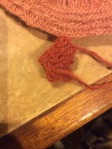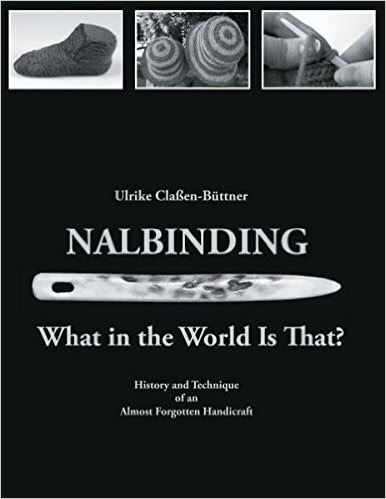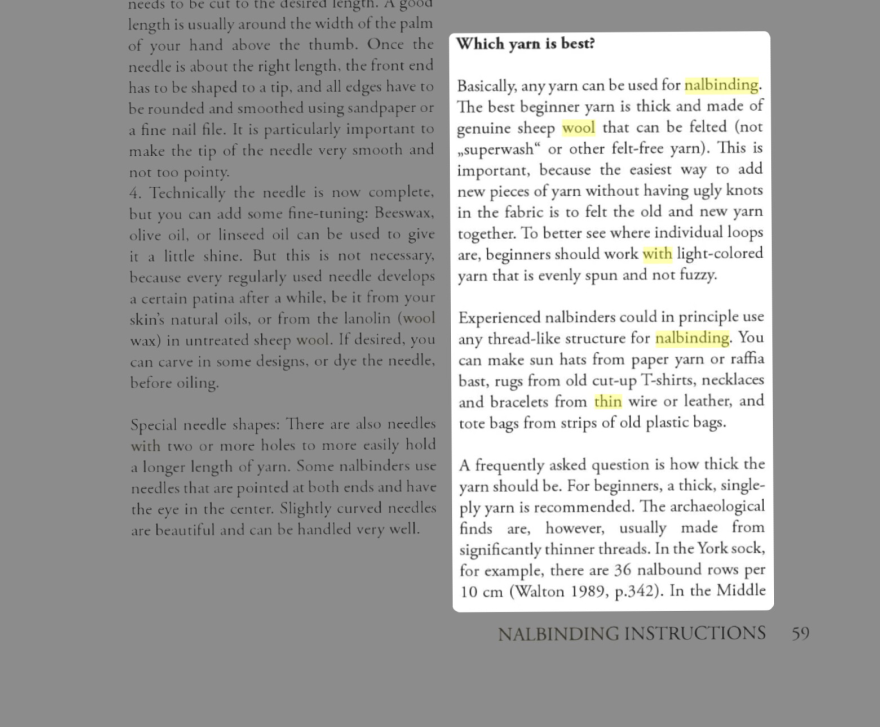I have in the last few weeks been looking into Nalbinding. I have done some before and made a few pairs of socks for people but have always thought I was doing a pretty “non standard” version of it in my opinion. The viking era, living history club I am part of has a few newbies who have asked me to teach them some basic nalbinding stitches. I thought I better hit the books and learn “Oslo” stitch with the thumb bondage etc. I came across a few interesting things that I don’t see replicated very much in living history circles here in Australia at least.

The first thing I came across was information on the importance of using natural fibres and not modern versions of fibres, sort of a no brainer really, vikings just did not have superwash wool or acrylic folks and acrylic dont felt or splice that well.
The second interesting thing I came across was that the stitch size was quite often much smaller than I had seen replicated in peoples reproductions. A good visual example of this is the above picture of the Coppergate Nalbinded sock. Its stitches are very fine. In the below reference they specifically point out that there were 36 rows of nalbinding in 10cms of the sock. Pretty fine stuff.
Thirdly superthick multi-plyed wool wasn’t really a happening thing either in the viking era that I know of, does that coppergate sock yarn look super thick and multi-plyed to you? Happy to see some example otherwise please!
Forthly, narlbinding is made out of pieces of wool that you splice together as you go. It never made sense to me why you would cut a piece of wool from a ball, nalbind it and then splice another newly cut piece of wool from a ball of yarn. That’s just rediculously counter productive…isn’t it? Well yes….until I started dropspindle spinning and weaving cloth (more about that in a moment)
I can tell you with some authority that when you dropspindle all your yarn from scratch and you dye it with period dyes and methods, nothing on earth is going to make you throw your cloth weaving, loom waste away. NOTHING! The labour involved you certainly appreciate. Yarn bombing becomes the most repugnant thing on earth…
So there I was amassing quite a collection of precious loom waste in a box and my only solution for its use was to keep it for future tapestry weaving.
As you can see there is quite a lot of fine spun, period dyed and natural coloured icelandic and spelsau wool offcuts.
Fine Nalbinding was probably made of loom waste! Yes that’s it. No one was cutting little strips of wool from a ball and resplicing them, they were frugally using their weaving waste and splicing it together. It also explains some of the interesting colour usage! Totally makes sense in my opinion.
So I started Oslo stitch with some of my period loom waste, which is fairly fine wool as you can see above. The thumb method was giving me rediculously big holes and not really making anything that would keep head, hands or feet warm. What is with the thumbs? It’s quicker and works great with a fat single ply yarn but not so great for me with thin yarn. So I decided to just use a needle and eyeball it as I went. Freehand! A bit more research and I find it was a perfectly legitimate way of nalbinding.
So I have started freehanding instead and I am getting okay results for eyeballing stitches with thin, dropspindled yarn. It’s not the best nalbinding in the world so far, I need to practice more but its done with thin dropspindle spun, icelandic wool, dyed with madder and it is most likely a much more period accurate way of using up precious loom waste to make handy warm items and I am just eyeballing it as I go.

My next project will be to buy this excellent reference book which came up when ever I googled one of my questions and I have highlighted some of the helpful info that came up. Thankyou Ulrike for your book and knowledge!

which can be found at this link. http://www.amazon.com/gp/product/3734787750/ref=pd_lpo_sbs_dp_ss_1?pf_rd_p=1944687642&pf_rd_s=lpo-top-stripe-1&pf_rd_t=201&pf_rd_i=8771459103&pf_rd_m=ATVPDKIKX0DER&pf_rd_r=1J10SVQ8GWNAA8GM3M2K




I’ve made several tight bound mittens and a pair of socks…the thick stuff just isn’t good for summer. I use the Oslo stitch and bind as per usual, but when I drop the stitch off of the thumb I pull the thread so that i can barely see the stitch between my thumb and fore finger. This gives me a tight fabric with even stitches 🙂
LikeLiked by 1 person
Hi Liv, good to hear from you. I think I will have to go to nalbinding school over there and see all the ways it is done. 😄
LikeLike
I would like to see your work Liv if you would not mind. I just started following your wordpress too! I think I can translate some of it with google!
LikeLike
I haven’t uploaded piccies of the socks yet since they were made on the way to market and went straight into use lol but you could have a look here for now
https://straumeyjar.wordpress.com/2013/03/29/nalebundet-sjal/
LikeLiked by 1 person
oh and thanks for following 🙂 it’s in face the blog of my viking reenactment group!
LikeLiked by 1 person
Its a great blog, I have to run it mostly through a translator but it is very interesting to learn about viking living history from people who are in the correct hemisphere 😉
LikeLike
Thanks 🙂 I have a great variety of people in my group and even if I suppose you’ll find others more dedicated to authenticity we’re learning as we go 🙂
LikeLiked by 1 person
Us too 😄
LikeLike
Your shawl is spectacular! Lovely!
LikeLike
Thanks 🙂 it very warm…made from Lett Loopi Icelandic yarn.
LikeLike
I have worked wth some of the lopi yarn, it is very nice.
LikeLike
it is, lovely colours and easily spliced 🙂
LikeLiked by 1 person
Yes they are!
LikeLike
did you know by the way that lopi means wool?
LikeLike
No 😊
LikeLiked by 1 person
just a note if you still need help getting your stitches tighter, there is a lady on Utube who has done some great stitch tutorials for nailbinding. https://www.youtube.com/channel/UCzZjQa5bQ9479V6Sk1n5gwg
on another note do you know if weavers ever sell their loom waste?
LikeLike
Thanks Donna, sorry it took me so long to reply, I just found your message today! Getting a bit better at the stitching.
LikeLike
I am not surebut it’s probably a good idea.
LikeLike